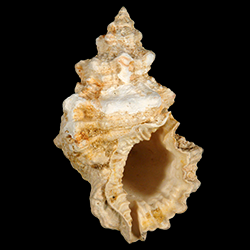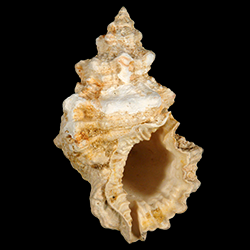
Bursidae

- Phylum: Mollusca
- Class: Gastropoda
- Order: Littorinimorpha
- Family: Bursidae
Overview
Common name: Frog snails
Key morphological features: The Bursidae range in size up to ~450mm in height. Their shells have prominent spires and are frequently fusiform or turbinate in shape. The whorls are rounded with prominent shoulders at the suture, and feature strong, rough ornamentation consisting of spiral beaded chords and knobs. Each whorl also features two prominent axial varices that frequently line up from whorl to whorl on the left and right sides of the shell. The aperture is irregularly oval in outline, has short siphonal and anal canals, and is ringed with short, stout teeth. Source: Davies, A.M. 1971. Tertiary Faunas Vol. 1, second edition. New York: American Elsevier Publishing Company, Inc. 571 pp.; Tunnell Jr., J.W., Andrews, J., Barrera, N.C., Moretzsohn, F. 2010. Encyclopedia of Texas Seashells. College Station: Texas A&M University Press. 512 pp.
Geological range: Eocene to Recent (Davies, 1971).
Geographic distribution: A distributional map for modern Bursidae may be accessed from OBIS. A distributional map for ancient Bursidae may be accessed from the Paleobiology Database.
Diversity: There are 53 recognized living species of Bursidae and 7 genera (WoRMS database, unvetted). The Paleobiology Database recognizes 10 fossil genera and 62 fossil species of Bursidae (unvetted).
Paleoecology: The Bursidae are carnivorous, epifaunal gastropods that generally inhabit hard grounds and reefs in nearshore intertidal and subtidal tropical environments, but can also be found at greater depths on the continental shelf. They prey predominantly on polychaete worms and bivalves. Source: Tunnell et al. (2010); Castelin et al. (2012).
Phylogenetic status: Monophyletic. The molecular phylogenetic analysis by Castelin et al. (2012) supports the monophyly of Family Bursidae.
